WW2 US Army Ribbons, Sterling Silver CIB, Silver Filled Jump Wings Garrison Cap
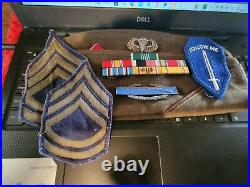
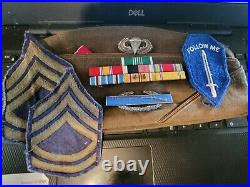
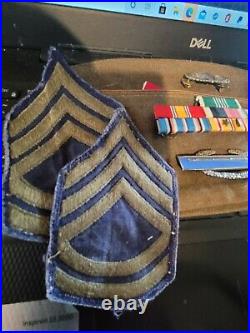
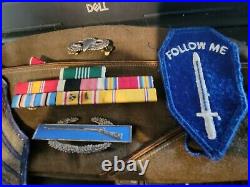
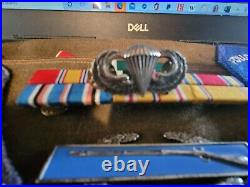
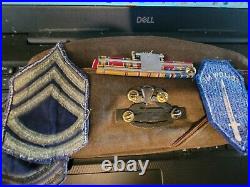
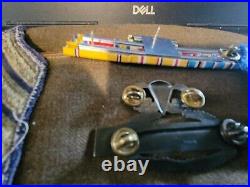
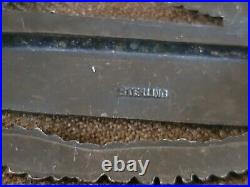
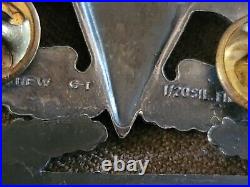

PLEASE FOLLOW OUR E BAY STORE. NOTE: THERE IS WW2 BRNZE STR WITH COMBAT V IN THIS GROUP , NOT IN PIC BUT YOU WILL RECIEVE. PLEASE LOOK AT ALL PICSAND READ WHOLE ADD!!! United States Army Infantry School. School headquarters' and the Airborne and Ranger Training Brigade's distinctive unit insignia.
US Army Training & Doctrine Command. From Wikipedia, the free encyclopedia.
The Parachutist Badge , also commonly referred to as "Jump Wings" is a military badge. Of the United States Armed Forces.The United States Space Force. And United States Coast Guard.
That do not award the Parachutist Badge, but their members are authorized to receive the Parachutist Badges of other services in accordance with their prescribed requirements. The DoD military services are all awarded the same Basic Parachutist Badge. Issue the same Senior and Master Parachutist Badges while the U. Issue the Navy and Marine Corps Parachutist Badge to advanced parachutists. The majority of the services earn their Basic Parachutist Badge through the U. The Army's Basic Parachutist Badge is awarded to all military personnel of any service who complete the US Army Basic Airborne Course. It signifies that the soldier is a trained military parachutist. And is qualified to participate in airborne operations. The badge and its sew-on equivalent may be worn on the Army Combat Uniform (ACU). The original Army Parachutist Badge was designed in 1941 by Captain.And approved by the Department of War in March of that year. The Parachutist Badge replaced the "Parachutist Patch" which had previously been worn as a large patch on the side of a paratrooper's garrison cap. LTG Yarborough also designed the Senior and Master Parachutist Badges and the addition of stars to portray the number of combat jumps. The flash that is worn behind the badge is also a contribution of William P.
To be eligible for award of the basic Parachutist Badge, an individual must have completed the Basic Airborne Course of the Airborne School of the United States Army Infantry School. To graduate, a student must complete the three-phase course consisting of a ground phase, a tower phase, and a jump phase. By the end of the course, a student will have completed five jumps in varying jump configurations, from a "no load" jump all the way to a full combat load jump at night. This article is about the US Army military award. For the Australian one, see Infantry Combat Badge.
Special Skill Group 1 Badge. Army infantry or special forces officers (SSI 11 or 18) in the grade of colonel or below, Army enlisted soldiers and warrant officers with an infantry or Special Forces military occupational specialty.The Combat Infantryman Badge (CIB) is a United States Army military decoration. The badge is awarded to infantrymen and Special Forces. Soldiers in the rank of colonel. And below, who fought in active ground combat while assigned as members of either an Infantry. Unit of brigade size or smaller at any time after 6 December 1941.
For those soldiers who are not members of an infantry, or Special Forces unit, Combat Action Badge. For soldiers with an MOS. In the medical field with the exception of a Special Forces Medical Sergeant.
(18D), the Combat Medical Badge. The CIB and its non-combat contemporary, the Expert Infantryman Badge.
(EIB), were created in November 1943 during World War II. To boost morale and increase the prestige of service in the Infantry. Specifically, it recognizes the inherent sacrifices of all infantrymen, and that they face a greater risk of being wounded or killed in action than any other military occupational specialties.
After the United States' declaration of war in 1941, the War Department. Had difficulty recruiting Infantry Branch. Volunteers, and the morale of soldiers in the Infantry Branch remained low, namely due to the fact that [o]f all Soldiers [sic], it was recognized that the infantryman continuously operated under the worst conditions and performed a mission that was not assigned to any other Soldier [sic] or unit... [t]he infantry, a small portion of the total Armed Forces, was suffering the most casualties while receiving the least public recognition.On 27 October 1943, the War Department formally established the Combat Infantryman Badge (CIB) and the Expert Infantryman Badge (EIB) awards in Section I, War Department Circular 269 (27 October 1943). The present war has demonstrated the importance of highly-proficient, tough, hard, and aggressive infantry, which can be obtained only by developing a high degree of individual all-around proficiency on the part of every infantryman. As a means of attaining the high standards desired and to foster esprit de corps in infantry units; the Expert Infantryman and the Combat Infantryman badges are established for infantry personnel. Moreover, War Department Circular 269 stipulated:.. Only one of these badges will be worn at one time" and "the Combat Infantryman badge is the highest award; the awarding of the CIB was officially authorized with an executive order dated 15 November 1943; later, on 30 June 1944, the U.
Congress approved an extra ten dollars in monthly pay to every infantryman awarded the CIBexcepting commissioned officers. The World War II regulations did not formally prescribe a specific combat service period establishing the infantryman's eligibility for being awarded a Combat Infantryman Badge, thus, in 1947, the U. Government implemented a policy authorizing the retroactive awarding of the Bronze Star Medal. Both awards required a commander's recommendation and a citation. Initiated this after Medal of Honor. Noted to him that: "It would be wonderful, if someone could design a badge for every infantryman who faces the enemy, every day and every night, with so little recognition". War Department Circular 105, dated 13 March 1944 amended WD Circular 269. BADGE Section 1, Circular No. 269 War Department, 1943, is amended by adding paragraph 8 as follows. Retroactive award of Expert and Combat Infantryman badges may be awarded to any infantryman who, on or after 6 December 1941, has established eligibility and been recommended for such award under the provisions of paragraph 2b or paragraph 3b. The Expert Infantryman badge may be awarded under paragraph 2a, only to those infantryman who have established eligibility and been recommended for such award on or after 27 October 1943. From the beginning, Army leaders have taken care to retain the badge for the unique purpose for which it was established and to prevent the adoption of any other badge that would lower its prestige.At the close of World War II, the largest war in which armor and artillery played key roles in the ground campaigns, a review was conducted of the CIB criteria with consideration being given to creating either additional badges or authorizing the badge to cavalry and armor units. The review noted that any change in policy would detract from the prestige of the badge.
A soldier must meet the following requirements to be awarded the Combat Infantryman Badge. Assigned to an infantry unit during such time as the unit is engaged in active ground combat. Actively participate in such ground combat.
Campaign or battle credit alone is not sufficient for award of the CIB. The specific eligibility criteria for the CIB require that an officer (SSI 11 or 18) in the grade of colonel or below, or an Army enlisted soldier or warrant officer with an infantry or Special Forces MOS, who subsequent to 6 December 1941 has satisfactorily performed duty while assigned or attached as a member of an infantry, ranger or special forces unit of brigade, regimental, or smaller size during any period such unit was engaged in active ground combat. Eligibility also includes soldiers or officers with an MOS other than infantry or Special Forces that hold a prior or secondary infantry or Special Forces MOS and that are assigned or temporarily attached to an infantry unit of any size smaller than a brigade. Eligibility for Special Forces personnel in Military Occupational Specialties (MOS) 18B, 18C, 18E, 18F, and 18Z (less Special Forces medical sergeant) accrues from 20 December 1989. Retroactive awards of the CIB to Special Forces personnel are not authorized prior to 20 December 1989.
A recipient must be personally present and under hostile fire while serving in an assigned infantry or Special Forces primary duty, in a unit actively engaged in ground combat with the enemy. The unit in question can be of any size smaller than brigade.
On or after 18 September 2001: a soldier must be an Army infantry or special forces officer (SSI 11 or 18) in the grade of Colonel or below, or an Army enlisted soldier or warrant officer with an infantry or special forces MOS, who has satisfactorily performed duty while assigned or attached as a member of an infantry, ranger or special forces unit of brigade, regimental, or smaller size during any period such unit was engaged in active ground combat. A soldier must be personally present and under fire while serving in an assigned infantry or Special Forces primary duty, in a unit engaged in active ground combat, to close with and destroy the enemy with direct fires. These soldiers must have been personally present and engaged in active ground combat, to close with and destroy the enemy with direct fires. Retroactive awards under these criteria are not authorized for service prior to 18 September 2001. Those soldiers possessing MOS of 18D who qualify for award of the CMB from 18 September 2001 to 3 June 2005 will remain qualified for the badge.
Qualifying conflicts, operations and periods. The CIB is authorized for award for the following qualifying wars, conflicts, and operations. To date, a separate award of the CIB has been authorized for qualified soldiers in the following qualifying periods. (1) World War II (7 December 1941 to 3 September 1945).
(2) Korean War (27 June 1950 to 27 July 1953). (3) Vietnam War and other operations (2 March 1961 to 10 March 1995). (a) Vietnam War (2 March 1961 to 28 March 1973) combined with qualifying service in Laos (19 April 1961 to 6 October 1962).
(b) Dominican Republic (28 April 1965 to 1 September 1966). (c) South Korea on the demilitarized zone (DMZ) (4 January 1969 to 31 March 1994). (d) El Salvador (1 January 1981 to 1 February 1992). (e) Grenada (23 October to 21 November 1983). (f) Joint Security Area, Panmunjom, South Korea (23 November 1984). (g) Panama (20 December 1989 to 31 January 1990). (h) SWA Conflict (17 January to 11 April 1991). (i) Somalia (5 June 1993 to 31 March 1994). (4) Global War on Terrorism (18 September 2001 to a date to be determined). (a) Afghanistan (OEF, 18 September 2001 to 31 December 2014; OFS, 1 January 2015 to a date to be determined). (b) Iraq (OIF, 19 March 2003 to 31 August 2010; OND, 1 September 2010 to 31 December 2011). (c) Iraq & Syria (OIR, 15 June 2014 to a date to be determined). NOTE: Subsequent awards of the CIB are not authorized for the same qualifying period, as outlined above. Subsequent awards of the CIB may be awarded provided the soldier has met eligibility criteria in separate Qualifying Periods/Eras. For example, a second award with superimposed star on the wreath could be awarded for a soldier who served in Somalia (3rd Qualifying Era) and OEF (4th Qualifying Era). In the Korean War: The special requirements for award of the CIB for service in South Korea are rescinded. Army veterans and Servicemembers who served in South Korea on or after 28 July 1953 and meet the criteria for award of the CIB may submit an application (to include supporting documentation) for award of the CIB. To date no qualifying period or authorization has been made for the Balkan conflicts (Albania, Bosnia and Herzegovina, and Kosovo). The original, World War IImodel CIB was a silver and enamel badge, consisting of a 3-inch-wide (76 mm) rectangular bar with an infantry-blue field upon which is superimposed a Springfield Arsenal Musket, Model 1795.The composite device is superimposed to an elliptic oak-leaf wreath, symbolizing steadfast character, strength, and loyalty. During World War II, there existed metallic, composite models of the CIB composed of a separate EIB rectangle-badge and oak-leaf wreath that then was pinned to the blouse, as a Combat Infantryman Badge. Later, a matte-black subdued metal badge was created for wearing on the fatigues in the field. Since World War II, the CIB has been made in cloth (colored and subdued) for wear, like the matte-metal model, on the fatigue field uniform, and, a miniature (1.25 inches long) lacquered-metal CIB model is available for wearing on the mess dress uniform and civilian clothes.
On 8 February 1952, the Army approved the addition of stars to the CIB indicating the soldier's having fought in more than one war. The first was the second-award CIB recognizing Korean War. Combat operations; in that time, the U. Army's Institute of Heraldry.Also had created eighth-award CIB designs. The second- through fourth-award CIB awards were indicated with silver five-point stars, one to three stars centered, at badge's top, between the tips of the oak-leaf wreath; the fifth- through eighth-awards of the CIB were indicated with gold stars. However, Army Regulation 600-8-22 (Military Awards) only authorizes up to three awards of the CIB.
There are four periods for which an award of the badge can be made. World War II (7 December 1941 to 3 September 1945). Korean War (27 June 1950 to 27 July 1953).Vietnam War and other Cold War era actions (2 March 1961 to 10 March 1995). War on Terror (18 September 2001 to a date to be determined). Currently, the Combat Infantryman Badge is worn one-quarter (0.25) inch above the service ribbons above the left-breast pocket of the Class-A uniform coat and of the other uniforms with which the CIB is authorized.
As of June 2011, the badge and its sew-on equivalent may be worn on the Army Combat Uniform (ACU). (BSM) is a United States Armed Forces decoration. Awarded to members of the United States Armed Forces. For either heroic achievement, heroic service, meritorious achievement, or meritorious service in a combat zone. When the medal is awarded by the Army. For acts of valor in combat, the "V" device. Is authorized for wear on the medal. When the medal is awarded by the Navy.For acts of valor or meritorious service in combat, the Combat "V". Officers from the other Uniformed Services of the United States. Are eligible to receive this award, as are foreign soldiers who have served with or alongside a service branch of the United States Armed Forces. The Bronze Star Medal was established by Executive Order. 9419, 4 February 1944 (superseded by Executive Order 11046, 24 August 1962, as amended by Executive Order 13286, 28 February 2003).
The Bronze Star Medal may be awarded by the Secretary of a military department or the Secretary of Homeland Security. With regard to the Coast Guard. When not operating as a service in the Department of the Navy. Or by such military commanders, or other appropriate officers as the Secretary concerned may designate, to any person who, while serving in any capacity in or with the Army. Or Coast Guard of the United States, after 6 December 1941, distinguishes, or has distinguished, herself or himself by heroic or meritorious achievement or service, not involving participation in aerial flight.(a) while engaged in an action against an enemy of the United States. (b) while engaged in military operations involving conflict with an opposing foreign force; or. (c) while serving with friendly foreign forces engaged in an armed conflict against an opposing armed force in which the United States is not a belligerent party. The acts of heroism are of a lesser degree than required for the award of the Silver Star.
The acts of merit or acts of valor must be less than that required for the Legion of Merit. But must nevertheless have been meritorious and accomplished with distinction.Redirected from Asiatic-Pacific Campaign Medal. And Department of the Navy. Armed forces for at least 30 days in the Asiatic-Pacific Theater between December 7, 1941, and March 2, 1946. Of the Second World War. Which was awarded to any member of the United States Armed Forces.
Who served in the Asiatic-Pacific Theater. The medal was created on November 6, 1942, by Executive Order. Issued by President Franklin D. The medal was designed by Thomas Hudson Jones.
The reverse side was designed by Adolph Alexander Weinman. Which is the same design as used on the reverse of the American Campaign Medal. And European-African-Middle Eastern Campaign Medal. There were 21 Army and 48 Navy-Marine Corps official campaigns of the Pacific Theater, denoted on the suspension and service ribbon. Of the medal by service stars.
Which also were called "battle stars"; some Navy construction battalion. Units issued the medal with Arabic numerals. Is authorized for those campaigns which involved participation in amphibious assault landings. The Fleet Marine Force Combat Operation Insignia. Is also authorized for wear on the medal for Navy service members who participated in combat while assigned to a Marine Corps unit.
The flag colors of the United States and Japan. Are visible in the ribbon. The AsiaticPacific Campaign Medal was first issued as a service ribbon in 1942. A full medal was authorized in 1947, the first of which was presented to General of the Army.
Equivalent of the medal was known as the European-African-Middle Eastern Campaign Medal. (1) The eastern boundary is coincident with the western boundary of the American Theater. (2) The western boundary is from the North Pole south along the 60th meridian east longitude to its intersection with the east boundary of Iran, then south along the Iran boundary to the Gulf of Oman and the intersection of the 60th meridian east longitude, then south along the 60th meridian east longitude to the South Pole. The 16 officially recognized US Army campaigns in the Asiatic-Pacific Theater of Operations are. Central Pacific: 7 December 1941 6 December 1943, allied landings on Tarawa. During the Gilbert and Marshall Islands campaign. 17 April 1942 2 September 1945. 3 June 1942 24 August 1943, the Aleutian Islands campaign. Northern Solomons: 22 February 1943 21 November 1944, part of the Solomon Islands campaign. 31 January - 14 June 1944, allied landings on Kwajalein.Western Pacific: 15 June 1944 2 September 1945, the Mariana and Palau Islands campaign. 26 March - 2 July 1945, the allied landings on Okinawa. South West Pacific Areas Command. 7 December 1941 10 May 1942, the Japanese conquest Philippines.
East Indies: 1 January - 22 July 1942, Japanese conquest. Of the Dutch East Indies. Papua: 23 July 1942 23 January 1943, part of the New Guinea campaign. 7 August 1942 21 February 1943, the Guadalcanal campaign.
24 January 1943 31 December 1944, the New Guinea campaign. 15 December 1943 27 November 1944. 17 October 1944 1 July 1945, allied landings and liberation of Leyte. 15 December 1944 4 July 1945, allied landings and liberation of Luzon. 27 February - 4 July 1945, allied liberation of the Southern Philippines during the Philippines campaign. The item "WW2 US Army Ribbons, Sterling Silver CIB, Silver Filled Jump Wings Garrison Cap" is in sale since Friday, April 9, 2021. This item is in the category "Collectibles\Militaria\WW II (1939-45)\Original Period Items\United States\Patches". The seller is "bigjeffnola" and is located in Madisonville, Louisiana. This item can be shipped to North, South, or Latin America, all countries in Europe, Australia, Japan, China, South Korea, Indonesia, Taiwan, South africa, Thailand, Hong Kong, Israel, New Zealand, Philippines, Singapore, Saudi arabia, United arab emirates, Qatar, Kuwait, Bahrain, Malaysia, Bangladesh, Brunei darussalam, Egypt, Jordan, Cambodia, Sri lanka, Macao, Maldives, Oman, Pakistan, Reunion.- Region of Origin: United States
- Modified Item: No
- Country/Region of Manufacture: United States
- Conflict: WW II (1939-45)
- Theme: Militaria
- Original/Reproduction: Original
